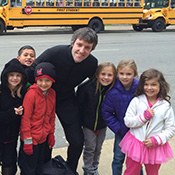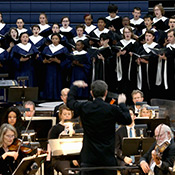
Reading, writing, ‘rithmetic, music, and art: ACE enhances learning for tens of thousands
David Lewellen
PUBLISHED
Tagged Under: ACE
Tens of thousands of schoolchildren have heard a Milwaukee Symphony educational concert over the years. But for children at 22 area schools, Arts in Community Education (ACE) goes much deeper.
The MSO’s unique ACE program gives students at partner schools a comprehensive, six-year curriculum that integrates music and other art forms into daily lessons. Classroom teachers don’t suddenly turn from reading or math to music; instead, the program piggybacks on what they’re already doing. First graders studying stories, for instance, might listen to Aaron Copland’s arrangement of the folk song “John Henry” to learn how music tells a story.
Children in K5 through fifth grade get three visits a year, either from MSO ensembles or from partner arts groups such as Milwaukee Ballet, Skylight Music Theatre, and Danceworks, and follow a year-long curriculum. The program culminates in the spring with a trip to Uihlein Hall to hear the musicians — many of whom the children will recognize — perform music that they have studied. “There’s the wow factor of hearing a whole symphony orchestra,” said MSO education manager Rebecca Whitney. “The musicians wave, and the kids wave back.”
ACE is “never meant to be a replacement for a music teacher,” said Karli Larsen, the MSO’s director of education, but the fact remains that many participating schools don’t have a full-time music teacher, and “this may be some of the only arts programming that students receive.” The participating schools run the gamut from wealthy suburban districts to Milwaukee city schools where most students qualify for free lunches. If teachers and administrators are fully on board, “the programming can be a success in all different districts and all different demographics,” said Whitney.
Brookfield Elementary principal Daniel Westfahl loves the integration of arts into the rest of the curriculum, dating back to his time as a classroom teacher; he mentioned using Saint-Saëns’s Carnival of the Animals in a science unit on animal classification.
In addition to ACE, the MSO offers many more young people’s concerts for which preparation involves a teacher guide and docents beforehand. But Larsen emphasized, “ACE is much more than just a field trip. Accountability is a part of this. It’s a broad learning philosophy.”
Violinist Andrea Wagoner agreed that children who attend ACE concerts “really get it and know how to listen. You really see the fruits of it.” She participates in a third-grade program with Theater Gigante that explains how music and dance have changed over the centuries.
“Most people only see the tip of the iceberg about ACE,” Whitney said. School employees don’t know how much work goes into coordinating the symphony’s schedule, and “the musicians don’t always know about the teachers’ personal investment.”
“For most MSO musicians, teaching is an important part of their career,” said clarinetist William Helmers, but ACE “gets you thinking in a different way.” For years, he teamed up with a bassist and two percussionists to tell first graders the story of the classic picture book The Snowy Day through music — but he composed the music himself for that unusual combination of instruments. Although Helmers doesn’t think of himself as a composer, ACE gave him a chance to stretch.
“I enjoy the little kids,” Helmers said. “They have incredibly open minds, they’re really curious, and they love seeing the instruments.”
Funding from individuals, corporations and foundations pays for ACE programming, and schools contribute a per-student fee as well. But the size of Uihlein Hall limits the total enrollment of the program to 1,800 students per grade.
As well as the educational value, bringing children to hear a professional orchestra may well help create future patrons. “It de-mystifies it,” Whitney said. “It’s not some scary thing where people say, ‘It’s not for me.’”



